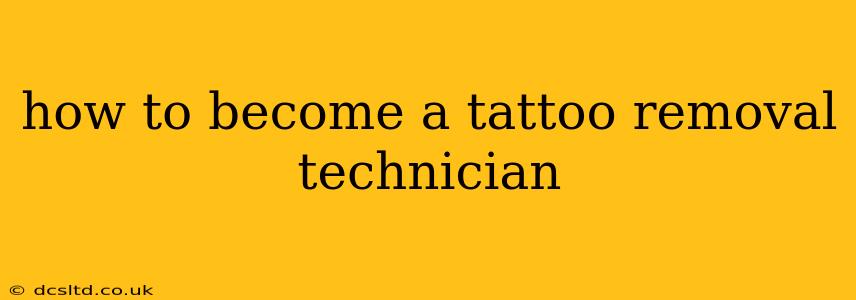Getting a tattoo is a significant decision, but so is removing one. The demand for skilled tattoo removal technicians is growing rapidly, fueled by advancements in laser technology and a rising number of individuals seeking tattoo removal. This comprehensive guide outlines the path to becoming a successful and sought-after tattoo removal technician.
What Does a Tattoo Removal Technician Do?
Tattoo removal technicians operate sophisticated laser equipment to break down the ink pigments in tattoos, ultimately causing the body to naturally eliminate them. This requires a deep understanding of laser technology, skin physiology, and patient care. The job involves client consultations, treatment planning, operating laser equipment, aftercare instructions, and managing client expectations throughout the process.
What are the Steps to Become a Tattoo Removal Technician?
The process of becoming a qualified technician involves several crucial steps:
1. Obtain a Relevant Education and Training:
This is the most critical step. While some states don't mandate specific certifications, pursuing formal training significantly enhances your credibility and marketability. Look for programs that offer comprehensive instruction in:
- Laser Technology: A thorough understanding of different laser types (e.g., Q-switched lasers, picosecond lasers) and their applications for various ink colors and skin types is essential.
- Skin Anatomy and Physiology: Knowing how skin reacts to laser treatment is crucial for safe and effective procedures.
- Tattoo Removal Techniques: Mastering the practical application of laser technology for various tattoo types and sizes is vital.
- Client Consultation and Assessment: Learn how to evaluate clients, assess their suitability for laser removal, and manage expectations.
- Safety Protocols and Hygiene: Maintaining strict hygiene standards and adhering to safety guidelines are paramount in this field.
- Business Operations: Understanding business management, marketing, and client relations is essential for building a successful practice.
Many reputable medical schools and aesthetic training centers offer specialized courses or programs in laser tattoo removal. Research programs thoroughly to ensure they cover all the necessary aspects and employ qualified instructors with extensive experience.
2. Gain Practical Experience:
Hands-on experience is invaluable. Look for apprenticeships or internships with established tattoo removal clinics or medical spas. This allows you to learn directly from experienced professionals, observe real-world procedures, and develop your skills under supervision.
3. Obtain Necessary Certifications and Licenses:
While licensing requirements vary significantly by state and country, obtaining relevant certifications and licenses is crucial for legitimacy and client trust. Research your local regulations and obtain the necessary permits to operate legally and ethically. Some certifications you may pursue include those offered by organizations such as the American Society for Laser Medicine and Surgery (ASLMS) or relevant national boards.
4. Build Your Professional Network:
Networking with dermatologists, plastic surgeons, and other medical professionals in your area can open doors to employment opportunities, collaborations, and continued learning. Attend industry conferences and workshops to stay updated on the latest advancements and best practices.
5. Develop Strong Business Acumen (If Starting Your Own Practice):
If you plan to open your own clinic, you’ll need a solid understanding of business management, including marketing, client acquisition, financial management, and regulatory compliance. Developing a strong business plan is crucial.
What are the necessary qualifications for a tattoo removal technician?
The qualifications can vary based on location, but generally include:
- Formal training: Completion of a recognized program in laser technology and tattoo removal.
- Certifications: Obtaining relevant certifications to demonstrate competency.
- Licensing: Adhering to all local licensing requirements.
- Practical experience: Hands-on experience under the supervision of experienced professionals.
What kind of laser is used for tattoo removal?
Several types of lasers are used, most commonly Q-switched lasers (both Nd:YAG and ruby) and picosecond lasers. The choice of laser depends on factors such as the ink colors, skin type, and depth of the tattoo.
How long does it take to become a tattoo removal technician?
The time required depends on the chosen training path. Some accelerated programs may take a few months, while comprehensive programs may span a year or more. Adding practical experience and obtaining licenses can extend the timeline further.
Is tattoo removal a good career?
The field offers excellent career prospects, with growing demand and the potential for high earning potential. However, success depends on your dedication to training, the quality of your services, and your business acumen (if you start your own practice).
By diligently following these steps and remaining committed to continuous learning, you can build a successful and fulfilling career as a tattoo removal technician. Remember, ethical practice, client safety, and continuous professional development are paramount in this dynamic and rewarding field.
